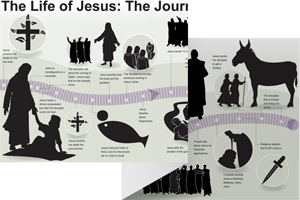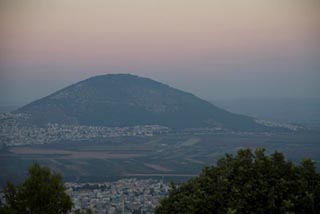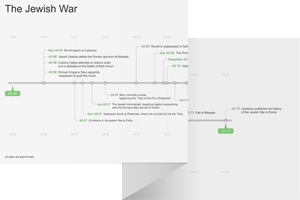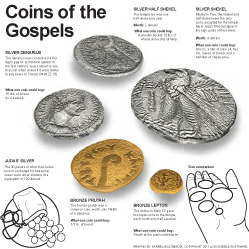17:1–13 Three disciples catch a glimpse of the intersection between heaven and earth, as they observe Jesus in His heavenly glory. |
17:1 Peter and James and John his brother These men compose the inner circle of Jesus’ disciples. They occasionally become privy to events that the rest of the group does not see.
on a high mountain There is no indication that Jesus and the disciples have moved away from Caesarea Philippi (16:13), located at the base of Mount Hermon. Another possibility is Mount Tabor,
Another possibility is Mount Tabor, southwest of the Sea of Galilee.
southwest of the Sea of Galilee.
17:2 he was transfigured Jesus’ appearance changes in some way, apparently reflecting His heavenly glory. The Greek verb used here, metamorphoō (meaning “to change outwardly or visibly”), describes an alteration in form.
changes in some way, apparently reflecting His heavenly glory. The Greek verb used here, metamorphoō (meaning “to change outwardly or visibly”), describes an alteration in form.
his face shone like the sun This description places Jesus within the prophetic tradition of Moses (see Exod 34:29, 30, 35; compare Dan 12:3; Rev 1:16).
(see Exod 34:29, 30, 35; compare Dan 12:3; Rev 1:16).
bright as the light Used elsewhere to describe heavenly garments (Matt 28:3; Mark 9:2–3; Rev 3:5).
17:3 Moses and Elijah The presence of these men might signify that both the Law (Moses) and the Prophets (Elijah) point to Jesus (see Matt 5:1 and note; 11:14 and note). Either directly or by allusion, Matthew often compares Jesus’ ministry with those of Moses and Elijah (4:8; 5:1; 8:1; 14:23; 15:29; 17:1, 9; 28:16; compare Exod 34:1–9; 1 Kgs 19:1–18).
17:4 three shelters Describes temporary residences or tents.
17:5 bright cloud Reminiscent of Yahweh’s presence appearing in a cloud in the ot (e.g., Exod 13:21; 16:10; 19:9; Num 12:5).
a voice from the cloud said A voice at Jesus’ baptism speaks these same words, which reflect Psa 2:7 and Isa 42:1 (compare Matt 3:17; 12:18).
17:6 they fell down on their faces A typical response to a divine encounter (e.g., Ezek 1:28; Dan 10:9,15–19; Rev 1:17).
17:7 do not be afraid A common divine greeting to mortals (e.g., Dan 10:12; Gen 15:1; 21:17; Luke 1:13, 30).
17:9 raised from the dead Jesus mentions His forthcoming resurrection for the second time (see Matt 16:21).
17:10 Elijah must come first Malachi had prophesied that Elijah would come before the Messiah (Mal 4:5). See note on Matt 11:14.
17:11 Elijah indeed is coming In vv. 11–12, Jesus could be referring to two Elijah-figures—one in the future and one in the past—or He might be restating the prophecy of Mal 4:5 and then speaking about its fulfillment in John the Baptist.
17:12 did with him whatever they wanted Refers to John the Baptist’s beheading (14:6–11).
17:14–20 Apparently back in Caesarea Philippi (16:13), Jesus encounters a demon-possessed person and demonstrates His power over evil. His disciples had tried to cast out the demon, but they failed due to their weak faith. |
 Miracles of Jesus Table
Miracles of Jesus Table
Jesus’ Miracles in Gentile Cities | |
Gadara/Gerasenes | |
Tyre and Sidon | |
Caesarea Philippi | |
Decapolis | |
17:16 I brought him to your disciples This may have occurred while Jesus was away (see Matt 17:1–13).
17:17 perverse Jesus rebukes the people of His day for their weak faith and distorted perception (compare Deut 32:5, 20). This criticism might be aimed at His disciples.
Jesus Heals an Epileptic Boy | ||
17:20 your little faith The people’s lack of faith is a repeated theme in Matthew’s Gospel (Matt 14:16–21; 15:16, 23, 44; 16:5, 22; 17:4). See 6:30 and note.
faith like a mustard seed A minuscule amount of faith can overcome overwhelming obstacles. See 13:31 and note.
17:22–23 Jesus again predicts His death and resurrection (compare 16:21; 17:9, 12). |
17:22 Son of Man See 8:20 and note.
be betrayed Matthew’s first reference to Jesus’ impending betrayal by Judas Iscariot.
17:23 extremely distressed The disciples are grieved, but they do not dispute this prediction, as Peter did the first time (see 16:22–23).
17:24–27 Unique to Matthew’s Gospel, this passage addresses whether Jewish followers of Jesus’ day should continue to pay the temple tax. This was particularly relevant to Matthew’s audience, since they were most likely Jews. Jesus’ response not only communicates the continued sanctity of the temple, but also demonstrates the miraculous ways in which God provides for His people. |
17:24 double drachma tax Every Jewish man 20 years and older was required to pay the temple tax, which was used for the general maintenance of the temple (Exod 30:13–14, 16). Priests (Levites) were exempt, and by Jesus’ time some rabbis were as well.
Peter The leader of the Twelve (see 14:28 and note).
17:26 the sons Just as children of earthly kings are tax-exempt, so too the children of the heavenly King, Jesus, have no obligation to pay a tax for His temple. Jesus’ followers are not required to pay the temple tax, but He makes a way for them to do so anyway (compare 22:15–22).
17:27 do not give offense Jesus gives instructions that allow Peter to pay the tax voluntarily, to avoid offending the authorities.
a four-drachma coin A miraculous provision—and exactly the amount needed for Jesus and Peter to pay the temple tax.

|
About Faithlife Study BibleFaithlife Study Bible (FSB) is your guide to the ancient world of the Old and New Testaments, with study notes and articles that draw from a wide range of academic research. FSB helps you learn how to think about interpretation methods and issues so that you can gain a deeper understanding of the text. |
| Copyright |
Copyright 2012 Logos Bible Software. |
| Support Info | fsb |
 Loading…
Loading…






